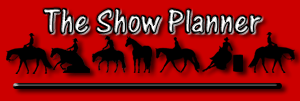 |
|
Show Horse Promotions Mary Murray
|
Body ClippingThis is a controversial subject at the very least. Iíve body clipped various horses (and dogs) many times over the years and I find that if done properly it is well worth the effort. Iíve had those horses that would look like a Shetland even while wearing the best of blankets all winter under lights. Those horses would get an annual body clipping in the Feb-Mar time frame so that riding in the Spring heat of North Carolina would not cause them to sweat unduly. Iíve clipped horses as late as April and not experienced any problem with their show coats for that summer even though I constantly hear that body clipping ruins their natural hair coats. For this you have to form your own opinions, I just donít think it does. It does take 2-3 wks before a body clipped horse looks natural (I've seen some that were gorgeous just after clipping). I donít body clip a pasture horse until all danger of cold/cool weather has passed. I body clip these horses as a convenience for me and for them. I will body clip a stalled horse only if I have a blanket for that horse to wear. Items to have on hand
I like to start on the neck and work backwards. For the first pass, always go WITH the lay of the hair (face the blades towards the rear of the horse). Stop at the top of the legs with the large clippers and after finishing the entire body you can use smaller clippers to trim the legs. Be cautious around the mane Ė you donít want to end up roaching your horseís mane.
I usually do the head and legs last or sometimes even the next day. I have a miniature horse that stays in the pasture and I trim his entire head several times during the winter. If I donít his halter gets too tight on him Ė when his head is trimmed his halter is very loose (he grows a massive amount of hair). I body clip a path for his harness surcingle in the winter when Iím doing any winter driving. It is the only way his harness will fit. I body clip his neck when it is time for the vet to give shots (so the vet can find his neck). On your first clipping task, make sure you set aside several hours for completion of the task. The more you do this the faster you will become. I can usually trim an entire horse (that is cooperative) in 45 minutes.
© 2000 - 2010 Show Horse Promotions The Show Horse Promotions web site is an informational web site, this information is subject to change without notice. Any use of, or actions taken based upon any of the information contained on this web site is done entirely at your own risk. Show Horse Promotions expressly prohibit you from republishing or redistributing this content without first receiving our written consent. By using this site, you agree not to hold us liable for any errors or delays in this content, or for any actions that you take in reliance thereon. This site contains links to other Internet sites. These links are not endorsements by us of any products or services in those sites, and we have not endorsed or approved any information in those sites. |
|
||||||||
